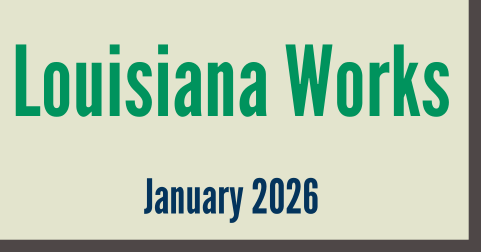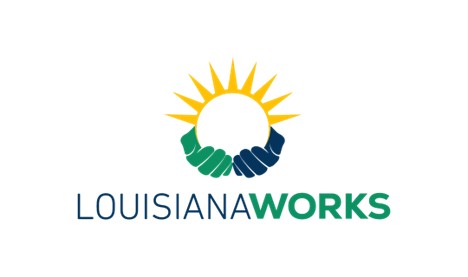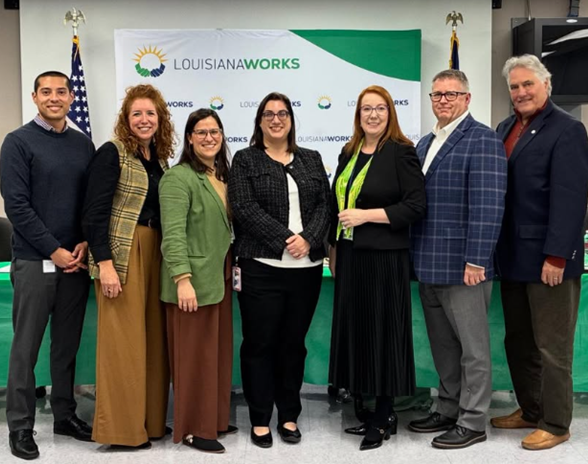IAIABC Member Spotlight
Each month, the IAIABC highlights one of its member organizations, asking about what the organization does; what challenges it sees workers' compensation facing; and why they're involved with the IAIABC. Find past member spotlights here.

IAIABC: Please provide an organizational overview (number of employees, years in business, vision)
Brian Blackwood, Assistant Secretary, Office of Workers' Compensation Administration, Louisiana Works: Louisiana Works is the state’s comprehensive workforce resource, providing unemployment insurance, workers’ compensation services, and workforce development programs. Our mission is to transform lives by connecting individuals to meaningful employment opportunities while empowering businesses with a skilled and prepared workforce. Serving jobseekers, employers, and communities across Louisiana, Louisiana Works eliminates barriers and streamlines access to essential workforce services. What sets us apart is our “One Door” approach, which delivers multiple resources through a seamless, customer-focused experience designed to help individuals achieve lasting financial independence.
Housed within Louisiana Works is the Office of Workers’ Compensation Administration (OWCA), established in 1983 to administer the Louisiana Workers’ Compensation Act. Louisiana’s workers’ compensation system provides benefits, including medical care, wage replacement, rehabilitation, and death benefits, for employees who experience job-related injuries or illnesses under a no-fault system.
The office exercises its authority under Title 23 of the Louisiana Revised Statutes. There are approximately 120 employees with OWCA who help administer the Act throughout the state.
IAIABC: How does your organization serve the workers’ compensation industry?
BB: The Louisiana Office of Workers’ Compensation Administration (OWCA) serves the workers’ compensation industry by administering and enforcing the Workers’ Compensation Act in a manner that is fair, efficient, and consistent with state law. Our most important role is to balance the interests of injured workers, employers, insurers, and medical providers while facilitating the timely return of injured employees to productive employment.
OWCA provides a comprehensive regulatory and adjudicative framework that ensures claims are resolved promptly and in accordance with statute and rule. This includes overseeing dispute resolution through the workers’ compensation courts, maintaining and updating medical treatment guidelines and reimbursement schedules through the Administrative Procedure Act, and ensuring uniform application of Louisiana Administrative Code Title 40 across the system.
In addition, OWCA plays a critical role in system integrity and stability by monitoring compliance, managing the Second Injury Board, overseeing self-insurance and claims administration requirements, and providing guidance and transparency to stakeholders. Through education, rulemaking, enforcement, and collaboration, OWCA helps promote predictable outcomes, cost containment, and workplace safety—supporting both injured workers’ access to benefits and employers’ ability to operate within a clear and consistent workers’ compensation framework.

IAIABC: What do you see as some of the major challenges the industry is facing, and how can we as a community address them?
BB: The workers’ compensation industry is facing several significant and interconnected challenges, many of which require coordinated, multi-stakeholder solutions rather than isolated agency action.
One of the most pressing challenges currently facing OWCA is the medical fee schedule. Unfortunately, it has not been updated in approximately 30 years, resulting in reimbursement rates that are not aligned with current industry standards and the omission of certain billing codes from the schedule. These gaps can affect provider participation and create inefficiencies within the workers’ compensation system.
 OWCA, stakeholders, and legislators are actively engaged in discussions to balance timely access to appropriate medical care with cost containment and long-term system sustainability. Key challenges include medical inflation, evolving treatment modalities, and increased administrative complexity, all of which place pressure on injured workers, medical providers, employers, and insurers alike. Addressing these issues will require a collaborative, community-wide approach that emphasizes evidence-based medical treatment guidelines, regular updates to rules and the medical fee schedule, data-driven decision-making, and open dialogue among regulators, providers, payers, and employers to improve clarity and reduce unnecessary disputes.
OWCA, stakeholders, and legislators are actively engaged in discussions to balance timely access to appropriate medical care with cost containment and long-term system sustainability. Key challenges include medical inflation, evolving treatment modalities, and increased administrative complexity, all of which place pressure on injured workers, medical providers, employers, and insurers alike. Addressing these issues will require a collaborative, community-wide approach that emphasizes evidence-based medical treatment guidelines, regular updates to rules and the medical fee schedule, data-driven decision-making, and open dialogue among regulators, providers, payers, and employers to improve clarity and reduce unnecessary disputes.
Secondly, gaps in education and communication continue to contribute to disputes, delays, and misunderstandings within the workers’ compensation system. OWCA’s ongoing goal is to expand outreach by improving access to plain-language resources and strengthen education efforts at state-wide conferences and in-house training for stakeholders. Fostering partnerships among regulators, industry groups, and professional associations can further enhance trust, improve compliance, and promote consistency across the system.
By working collaboratively—sharing best practices, leveraging data, modernizing systems, and maintaining open lines of communication—the workers’ compensation community can more effectively address these challenges while preserving the system’s core mission: supporting injured workers, promoting safe workplaces, and ensuring fair, timely, and efficient outcomes for all stakeholders.
IAIABC: Are there any projects/programs/initiatives going on at your organization that you are particularly excited or enthusiastic about?
BB: One initiative we are particularly enthusiastic about at the Louisiana Office of Workers’ Compensation Administration (OWCA) is our transition toward a more paperless, technology-enabled workers’ compensation court system, which directly supports the broader Louisiana Works vision of consolidating services to better serve the state.
As Louisiana Works moves toward one location, one system, and one comprehensive approach to workforce solutions, OWCA’s modernization efforts are eliminating barriers created by paper-based processes, fragmented records, and inconsistent workflows. By expanding electronic filing, digital records management, and standardized systems across districts, we are improving access, increasing efficiency, and accelerating case resolution for injured workers, employers, and industry partners.
This initiative not only strengthens court operations, but also aligns workers’ compensation more seamlessly within Louisiana’s integrated workforce ecosystem—supporting faster return-to-work outcomes, better data sharing, and more predictable results statewide. It reflects a shared commitment to removing administrative obstacles and delivering modern, responsive services that meet the needs of today’s workforce and employers.

IAIABC: What's an interesting fact about your organization that most people don't know?
BB: An important and often overlooked aspect of OWCA’s mission is that its role extends well beyond dispute resolution. OWCA administers a federally approved OSHA On-Site Consultation Program, which provides free, confidential, and non-enforcement workplace safety services to employers across Louisiana. By helping employers identify and correct hazards before injuries occur, this proactive program directly contributes to reduced injury rates, improved compliance, and lower workers’ compensation costs.
This has been another exceptional year for the OSHA Consultation Program. The program continued to strengthen working relationships with employers in high-hazard industries, including construction, logging, nursing homes, and oil and gas. During the year, the program identified 995 serious and imminent hazards, demonstrating its critical role in injury prevention. Through on-site consultation visits, targeted outreach, and employee training, the Louisiana On-Site Consultation Program continues to deliver high-quality safety services to employers statewide.
The OSHA Consultation Program provides on-site consultative visits at the request of employers, with particular emphasis on industries with elevated safety risks. Its ongoing objective is to improve the efficiency, quality, and effectiveness of safety services for both employers and employees in Louisiana. These goals are achieved through consultation visits, outreach campaigns, training and technical assistance, and support of specific OSHA performance goals, including those established for FY 2024.
Lower accident rates have resulted from Louisiana’s strengthened safety efforts. Similar to findings in 2023, OSHA 300 data reviewed during consultation visits showed that sprains, strains, and tears remain the most common workplace injuries, with upper extremities being the most frequently affected body part. The majority of injuries and illnesses were associated with overexertion and bodily reaction. In response, the program placed a strong emphasis on ergonomics and proper body mechanics to help reduce these types of injuries.
Another less visible program is OWCA’s the Second Injury Fund (SIF). It was established in 1974 to encourage the employment, reemployment, and retention of workers with pre-existing permanent partial disabilities. The SIF protects employers, group self-insurance funds, and insurers from excess workers’ compensation liability when a subsequent compensable injury, combined with a pre-existing disability, results in a greater overall disability than would have occurred from the later injury alone. In such cases, the SIF provides reimbursement for eligible workers’ compensation benefits paid.
This protection limits liability for self-insured employers by capping total claim costs and reducing exposure to high-cost claims. Insured employers similarly benefit through lower reserve amounts reported to the National Council on Compensation Insurance (NCCI), which can minimize adverse impacts on experience modification factors. Lower experience modifications can lead to reduced insurance premiums and improved access to contracted work, providing meaningful economic relief while supporting the continued employment of workers with disabilities.
In short, the Second Injury Fund promotes the hiring and retention of individuals with disabilities while stabilizing employer costs and supporting the long-term sustainability of Louisiana’s workers’ compensation system. Although it operates largely behind the scenes, the SIF has a significant economic and workforce impact statewide.
IAIABC: Why is your organization a member of the IAIABC? What would you tell others about the benefits of membership?
BB: OWCA is a member of the IAIABC because its work directly supports our statutory and operational responsibilities, including the data collection and reporting requirements set forth in Louisiana law. The IAIABC’s leadership in developing international standards—particularly for electronic data interchange—makes insured and self-insured work-related injury and illness submissions more consistent, efficient, and easier to administer across jurisdictions.
Participation in IAIABC committees, such as the Claims, Proof of Coverage, and Systems Committees, allows OWCA to learn from other jurisdictions, share practical solutions, and help shape standards that address real-world administrative and regulatory challenges. This collaborative environment strengthens our ability to implement best practices while maintaining compliance with Louisiana’s unique statutory framework.
IAIABC membership also promotes adaptability and agility. For example, during the COVID-19 pandemic, OWCA was able to incorporate COVID-specific analytics into our leading indicators and publications by leveraging shared expertise and data standards developed through the IAIABC community. That ability to respond quickly to emerging issues is critical to maintaining system stability and transparency.
Previous Member Spotlights
Ametros - November 2025
Sapiens - October 2025
Minnesota Department of Labor and Industry's Workers' Compensation Division - September 2025
Texas Department of Insurance, Division of Workers' Compensation - August 2025
Sentry Insurance - June 2025
Enlyte - May 2025
Linea Solutions: Special Edition - April 2025
Washington State Department of Labor and Industry - March 2025
WCF Insurance - January 2025
CadenceRX - November 2024
PERMA - October 2024
Workplace Safety and Insurance Board (WSIB) - September 2024
American Medical Association (AMA) - August 2024
Association of Workers' Compensation Boards of Canada (AWCBC) - July 2024
American Association of Payers, Administrators, and Networks (AAPAN) - June 2024
The Beacon Mutual - May 2024
Ohio Bureau of Workers' Compensation - April 2024
Arbicare - March 2024
Acuity Insurance - February 2024
Alaska Division of Workers' Compensation - January 2024
Harvard MedTech - November 2023
Cottingham & Butler Claims Services - October 2023
NCCI: Special Edition - September 2023
Kansas Workers' Compensation Division - July 2023
Workers' Safety and Compensation Board Yukon - June 2023
U.S.Able MCO - May 2023
MDGuidelines - April 2023
Workers' Compensation Research Institute - March 2023
Commonwealth of Massachusetts Department of Industrial Accidents - February 2023
Linea Solutions - January 2023
Idaho Industrial Commission - December 2022
Sedgwick - November 2022
Ebix - September 2022
Sikich - August 2022
Saskatchewan Workers' Compensation Board - July 2022
Colorado Division of Workers' Compensation - June 2022
FAIR Health - May 2022
Aerie EDI Group - January 2022
- Paradigm - December 2021
- Oklahoma Workers' Compensation Commission - November 2021
- ODG by MCG - September 2021
- Care Bridge International - June 2021
- Missouri Division of Workers' Compensation - May 2021
- California Workers' Compensation Institute - April 2021
- Iowa Division of Workers' Compensation - March 2021
- Nebraska Workers' Compensation Court - February 2021
- Verisk/ISO - January 2021
- Ohio Bureau of Workers' Compensation - December 2020
- The Workplace Safety and Insurance Board (WSIB) - November 2020
- VPay - October 2020
- National Council on Compensation Insurance (NCCI) - September 2020
- Optum - August 2020
- Utah Labor Commission: Division of Industrial Accidents - June 2020
- Healthesystems - March 2020
- Safety National - February 2020
- CompAlliance - January 2020
- California Self Insurers Security Fund - December 2019
- Wisconsin Worker's Compensation Division - November 2019
- The Black Car Fund - August 2019
- Pennsylvania Bureau of Workers' Compensation - July 2019
- NIOSH Center for Workers' Compensation Studies - June 2019
- Tennessee Bureau of Workers' Compensation - May 2019
- Florida Workers' Compensation Division - April 2019
- Concentra - February 2019
- Oregon Workers' Compensation Division - January 2019
- SFM - December 2018
- Montana Department of Labor and Industry Employment Relations Division - November 2018
- MyMatrixx, an Express Scripts Company - October 2018
- Virginia Workers' Compensation Commission - September 2018
- WorkComp Strategies - August 2018
- Michigan Workers' Disability Compensation Agency - July 2018
